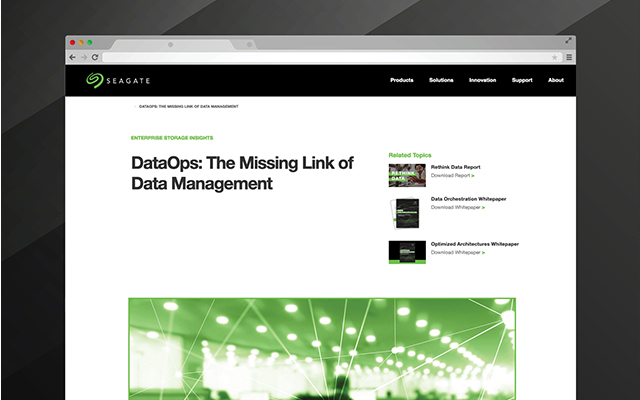As the volume, variety, and velocity of data increases, organizations can't rely on traditional data management methods. Rather, they require new solutions capable of deriving insights that deliver line-of-business value whiel satisfying evolving stakeholder expectations.
According to analysis in Seagate's recent Rethink Data report, DataOps—a portmanteau of "data" and "operations"—is the missing link in actionable information chains, offering a solution to some of the most pressing problems faced by IT teams and business owners alike. As part of the larger data management landscape, DataOps helps organizations realize the optimal value of this essential enterprise resource.
DataOps Defined
While 33% of enterprises have plans to build capacity and 30% have started the implementation process, just 10% of companies across regions and industries have fully implemented DataOps strategies.
Compared to the broad appeal of other digital transformation efforts—48% of enterprises have adopted public, multicloud strategies—DataOps deployments lag. In large part, this stems from the unique position of DataOps in the IT stack: While it leverages both new technologies and evolving processes, it's best defined as an emerging data discipline that connects consumers and creators to enhance collaboration and empower innovation.
To achieve this goal, DataOps deployments often use a combination of AI and ML technologies, along with extract-load-transform (ELT) functionalities to collect and correlate data from disparate sources. Effectively implemented, DataOps offers a significant competitive advantage.
Connecting Data Consumers and Data Creators
The primary function of DataOps is connecting data consumers—business decision makers—with data creators, to empower enterprise decision making.
Common data creators include machines such as IoT and endpoint devices, along with staff responsible for collecting and inputting key forms, documents, and other structured data. The target market includes operational managers—anyone in an organization who’s tasked with making line-of-business decisions. Here, it's critical to note that data creators often don't see the larger picture of data production, while consumers don't actually need data; rather, they need actionable information.
Bridging this gap is the primary function of DataOps. By correlating disparate data from cloud, core, and edge services—all produced by differing creators—effective DataOps initiatives can synthesize actionable insights that are applicable to specific data consumer groups.
Deploying DataOps
DataOps deployments offer significant benefits for organizations. Recent commentary by research firm Gartner agrees: "By introducing DataOps techniques in a focused manner, data and analytics leaders can affect a shift toward more rapid, flexible, and reliable delivery of data pipelines."
Organizational structures, however, often present challenges for DataOps efforts. Consider that 47% of companies now say they utilize multiple backup and recovery applications across the enterprise. While these disparate deployments make sense for geographically separated functions, effective DataOps depends on combining these data systems into a single, manageable entity. As noted in a Software Development Times report, preexisting DevOps structures may help smooth this transition thanks to the established framework of agile, iterative methodologies.
Moreover, despite the similarities in name, DataOps isn't simply DevOps for data. Rather, this emerging discipline represents a new way of approaching and interacting with data to deliver long-term value. Instead of taking the problem-focused approach favored by DevOps deployments, DataOps operates in the opposite direction—deriving new answers from existing data sets to narrow enterprise focus and deliver actionable insight.
Solving for Silos
While technology forms the primary potential barrier between enterprises and effective DataOps, human challenges around communication and workplace culture can also impact implementation. Silos are the most common iteration of this issue. Teams working on specialized projects are often reluctant to share control of critical data sets, in turn leading to the storage, management, and analysis of data in silos.
Solving this people problem requires a global data strategy that focuses on enterprise-wide standards, architecture, and management. For DataOps deployments at scale, this means folding key functions back under the purview of IT, in turn allowing all teams to access the same, globally accessible pools of data and DataOps initiatives to deliver value on demand.
The Future is DataOps
According to the Rethink Data survey, 42% of global organizations now say that DataOps deployments are "very important," while 23% deem them "extremely important"—and just 1% argue that these initiatives are not important to the future of business operations at all.
As a result, it's not a stretch to say that, much like their DevOps counterparts, DataOps solutions are not only here to stay, they are also here to play a critical role in the future of on-demand enterprise decision making. Unlike DevOps deployments, however, DataOps is critical for its role as the connective tissue between data creators and data consumers, enabling staff and stakeholders to derive maximum value from information assets.
With zettabyte-scale data collection, storage, and analysis now creating both systemic and operational challenges for capturing complete enterprise value, DataOps offers a simple, secure, and economic way to activate the inherent potential of data connections at scale.
Read more about how enterprises can put more business data to work in Seagate’s Rethink Data report.












